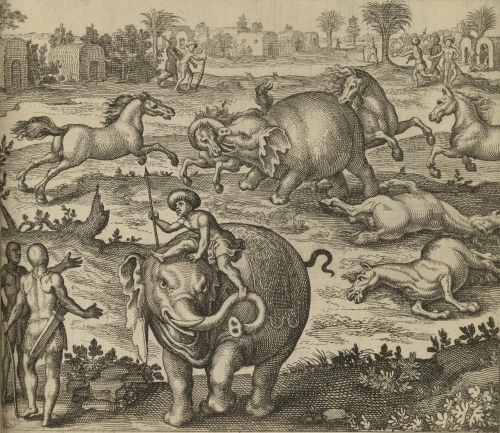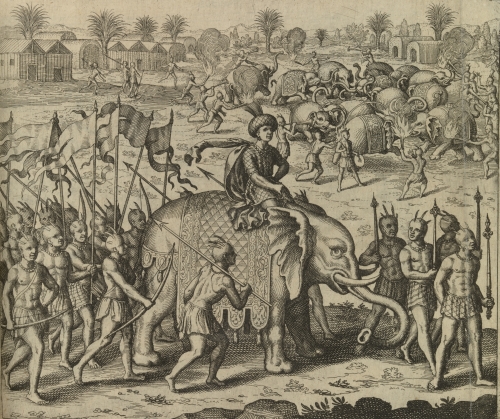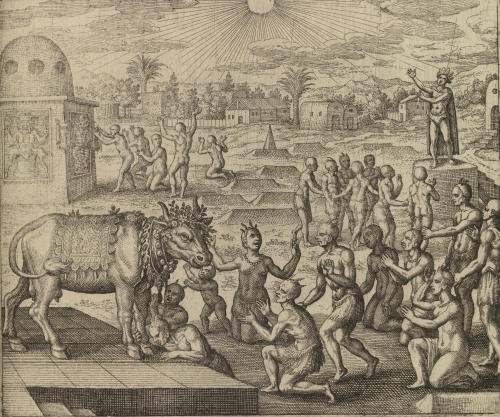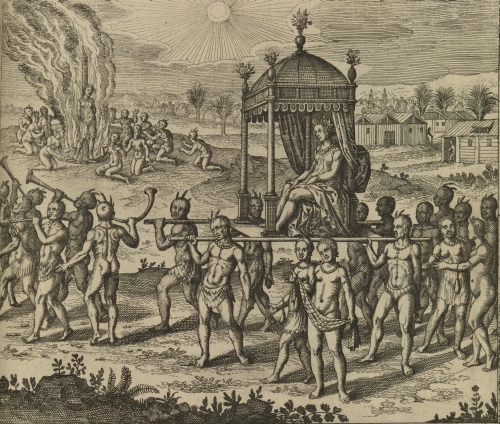Americans in Agra? Robert Coverte and the European Iconography of Mughal India
by Dr Michiel van Groesen, University of Amsterdam
In 1931 the eminent maritime historian Boies Penrose published a reprint of Robert Coverte’s True and Almost Incredible Report - a work, he stated, that was long overdue. Penrose explained that three centuries earlier Samuel Purchas had chosen not to include Coverte’s journal in the Pilgrimes account of the East India Company’s fourth voyage of 1608 which it described, even though Coverte’s account would not only have added substantial information on the fateful English expedition to Surat, it would also have justly enhanced the author’s reputation. Instead, Penrose claimed, Purchas’ decision not to include his report had contributed significantly to Coverte’s obscurity in later times.
What Penrose did not say was that one of Purchas’ closest colleagues did recognize the importance of Coverte’s work. In 1618, the engraver and bookseller Johan Theodore de Bry had the account translated into German and Latin in order to include it in his monumental collection of voyages, a hugely influential series of travel accounts which he and his father published in Frankfurt since 1590. The De Bry collection assembled roughly fifty travel accounts of Europeans who had visited the non-European world in the sixteenth and early seventeenth centuries, and amounted to twenty-seven volumes when it was finished in 1634. The America-series presented narratives of the New World, whereas the otherwise identical India Orientalis-series contained accounts of Africa and Asia - including Coverte’s report in Volume Eleven. The collection was rightly famous for its large copper engravings, some six-hundred in total. These images were to influence the European perception of other cultures until well into the eighteenth century. In this essay I will investigate how Johan Theodore de Bry manipulated Robert Coverte’s account to present readers with his own interpretation of Mughal India.
The Fourth Voyage of the East India Company was characterized by misfortune. Due to financial restrictions, the expedition, leaving London in March 1607, comprised only two ships, one of which never made it out of the English Channel. The other, the Ascension, was wrecked too, in September 1609, off the Gujarat coast. Ship and cargo were lost, but the remaining crew of fifty-five reached Surat, where the English governor, William Finch, would not allow them to stay. The crew scattered, each finding his own way home. Robert Coverte first joined a group under Commander Alexander Sharpey which made for the Mughal court in Agra. When Sharpey fell ill in Burhanpur, Coverte and only a handful of others continued to Agra, before eventually returning to England in 1611 by way of Persia and Aleppo. His account, published the following year, described the entire journey. He describes the religion of the people he calls the ‘Banyans’, and is especially intrigued by their veneration of cows, and the custom of sati. He describes at length the court in Agra, devoting many pages to his appreciation for Jahangir’s religious tolerance and his respect for Christianity.
Coverte’s account, first printed in 1612 and reprinted two years later, reached Frankfurt, the centre of the early modern book trade, very quickly. After having introduced the technique of including copper engravings into printed books to Germany, the De Brys were best known for making books with high-quality images. Many of their publications were large, attractive ‘coffee-table’ books, often issued in multiple languages, generally in German and Latin. The De Brys thus intended to reach both a domestic and international readership, and also managed to spread the investments made for producing copper engravings. The collection of voyages was the firm’s flagship publication. In Johan Theodore’s self-portrait, made at the peak of his success as a publisher in 1615, he included copies of the collection of voyages on the table in front of him (America / India Orientalis), despite not having extended either of the two series for several years. It appears that more than sixty percent of the firm’s revenues were based on the sale of their collection of voyages, even in a decade like the 1610s when few new volumes appeared.
So how did Johan Theodore de Bry manipulate the representations of Mughal India in Robert Coverte’s True and Almost Incredible Report? In this case, very few changes were made to the original text, and the German and Latin translations are identical. However, Robert Coverte’s printed account did not contain any illustrations, and since De Bry never published exclusively textual reports, changes were necessary here. Hence De Bry, as usual, invented suitable illustrations. For this volume, he created ten new copper engravings, eight of which were based on Coverte’s account. The first two in this cycle of eight depict hostile encounters on the way to Surat, in East Africa. The remaining six represent Coverte’s adventures in India. The engravings were not included in the text, but they were added in a separate section after the travel accounts, and thus presented what you might call a visual summary of the accounts included in the volume - with captions at the bottom.
Thematically, the six images can be divided into three groups of two. One set of two deals with the ‘ferocious’ animal world of India as described by Coverte which I have discussed elsewhere. The other four engravings made in the De Bry workshop portray the ruling elite of northern India and religious ceremonies in the subcontinent. The first set of two juxtaposes the ruler of the former Sultanate of Khandesh, annexed to the Mughal Empire by Akbar in 1601, and the official Coverte described as the ‘Lord Treasurer’ of the Mughals in Agra. The first image resembles the two engravings of the natural world, but whereas elephants and other ‘wild’ animals are being portrayed as symptomatic of the lack of human control in the previous images, here the elephants on display are described approvingly by Coverte. The Englishman explains that in Burhanpur, elephants perform a very useful service to man in times of war. This positive remark is omitted by Johan Theodore de Bry in the caption to this engraving. Instead, the caption cites a much later passage in Coverte’s account, at the court in Agra. For its conclusion, the same caption then returns to Burhanpur to inform readers that the local ruler “came from the warres with 1,500 Elephants, 30,000 horses, 10,000 Camels, and 3,000 Dromedaries”. Its final words cannot be traced to Coverte’s account at all:
“Which potentate, in Christianity or heathendom could assemble such a force? This is, therefore, according to the author, the true Magog, who will shortly wage war on the army camp of the Lord, that is the Christian Church, but who as a result will be ruined in a disgraceful manner”.
The newly invented conclusion is not only an extremely condemning interpretation of the elite in the Mughal Empire, it is also an outrageous misrepresentation of Coverte’s description of the subcontinent’s population. Coverte never mentioned “the true Magog”, the arch-enemy of Israel in the last days according to the New Testament, but instead praised Jahangir’s religious tolerance on several occasions. He claimed that the emperor “hath oftentimes said that he could find in his heart to be a Christian, if they had not so many Gods”, presumably a sneer at Catholicism, but certainly not a declaration of war against Christianity.
“[He will] urge none of what Nation soever to forsake their Religions, and of all other he maketh most accompt of Christians, and will allow them double the meanes that hee giveth to any other nation, and keepeth continually two Christian Friars, to converse with them in the Christian Religion and manners of Christendome”.
These statements made by Coverte throughout his description of the Mughal Empire were systematically neglected by Johan Theodore de Bry in favour of a much more divisive interpretation of the Indians’ religious viewpoints. The composition of the second illustration invented by De Bry, of Jahangir’s ‘Lord Treasurer’, was remarkably similar. The position of the palm trees in the background, the rounded roofs of the simple houses, the clothing of the protagonist, his position on top of an elephant, and the elephant’s garments were identical to those of the previous engraving depicting a different society five hundred miles further to the south.
The conflation of non-European identities is typical of the representations made in the De Bry workshop. The editorial strategy underlying the collection of voyages emphasized the ‘otherness’ of the non-European world in order to be able to sell the volumes across early modern Europe, to Protestant as well as Catholic readers. In the translations the De Brys made of the accounts, a strategy of confessional diversification could be applied - German translations for a readership of Protestants, different Latin translations for a readership of Catholics and humanists who did not appreciate the polemical tone in some of the travel accounts. Yet making different engravings for different readerships would have exposed the careful editing of the texts, and would have been rather costly too. For this reason, the De Brys systematically ‘othered’ the non-European world, insisting on the general lack of civility, and the marked absence of the Christian faith in America, Africa, and Asia.
This can best be shown with the final two engravings De Bry constructed to embellish Robert Coverte’s account. The first one illustrates the religious practices of the Banyans, a Hindu group Coverte encountered on the road to Agra, and whom he described as “a strange people in their beliefe”. What followed was the sort of episode that the De Brys, time and again, did select for depiction. “They honour God in a strange fashion”, Coverte explained, “in pictures of stone, hanging their beades on the heades of the pictures, and then with their faces towards the sun doe worship it”. And, he continued:
“I saw more than this, which was a Cow adorned with a veste of gold and many Jewels, her head bedecked with garlands and flowers, and then being brought to a buriall place, where they doe use to make Sermons, they kisse her feet and teats, and worship her, that it grieved mee to see their fond superstition, and abhominable Idolatry”.
This time the choice of words in the original account suited De Bry’s objectives, and the text was left unchanged for the caption, and the way Johan Theodore depicted the Banyans was condescending too. Should he have wanted to create a reliable image of the “Banyans from Cambaya”, he would have had to look no further than his own collection. In Volume II of the India Orientalis-series (1598), the De Brys had included a copy of a sketch made from life by the Dutch pioneer Jan Huygen van Linschoten. Here the Banyans “knew a lot about minerals”, according to Van Linschoten, “and were very well practiced in writing and calculating”. In a much more positive reading of their rituals, Van Linschoten in his Itinerario stated that the Banyans
“do not eat animals nor do they kill them […] They pay a ransom for animals that are designated to be killed by the Portuguese and the Christians. They take very good care of injured animals, and to improve the condition of these animals is considered by them the highest form of piety”.
Twenty years later, when De Bry had to depict the same ethnic group again, the beautifully dressed and highly civilised Banyans included in Van Linschoten’s Itinerario ánd in their own India Orientalis II, were systematically undressed, and their religious practices were reduced to graphic forms of animism and sun worship that were condemned throughout Europe because they were thought to have been authored by Satan, whose universally recognizable image Johan Theodore included in the background for good measure. Finally, in order to point readers to the desired interpretation of his image, De Bry lifted the word “Idolatry” from Coverte’s passage on the Banyans, and used it as part of the title of this engraving.
The final illustration of the cycle of six invented by De Bry depicts another Hindu ritual Coverte witnessed, the practice of sati. Like with the Banyans, the De Bry translations follow Coverte’s description of sati closely. Coverte writes that
“A young woman […] whose husband being dead […] was brought to the place of Execution, where was a stake and a hole to set her feet in, and so being tied to the stake, all her kindred kneeling round about her, & praying to the sun and their other Idols, the fire was set to her, she having under each arme a bagge of gunpowder, and a bagge betwixt her legges, and so burnt to death”.
Once again, De Bry made a new engraving for something they had already depicted two decades earlier in their volume devoted to Van Linschoten’s Itinerario. This image of sati had acquired canonical status in early modern Europe’s iconography of widow burning in India. Presumably De Bry decided to make a new engraving in order to depict a different form of sati than the one described by Van Linschoten. Coverte, according to his account, did not witness the widow jumping into the flames to be reunited with her deceased husband. Instead he professes to have seen a widow burning at the stake, in a ceremony that at least visually was arrestingly similar to the burning of witches in early modern Europe.
One aspect of this cycle of six new engravings that is particularly striking is the way De Bry depicted the inhabitants of Mughal India Coverte had encountered. Whereas Johan Theodore resisted the temptation to borrow elements from the engravings he had previously made of early modern India, he did copy elements of images he had made for the collection earlier. He mainly relied, however, on images of Virginia and Florida made by his father in the early 1590s. The procession which brought the grieving widow to the stake in India as observed by Coverte was largely inspired by this engraving of the chosen wife of a Floridian chief, based on the watercolours of the Huguenot traveler Jacques Le Moyne de Morgues, and included by Theodore de Bry in Volume II of his America-series in 1591. The rituals of the Banyans, are reminiscent of the engraving of the offering of a stag to the sun in Florida, that was - literally - a world away of Van Linschoten’s ethnographic sketch, another of the images made in Florida by Jacques Le Moyne.
The immediate inspiration for the imagined inhabitants of Mughal India, however, was formed by the much more recent accounts of colonial Jamestown as written by Ralph Hamor and John Smith. These accounts had been published in English for the first time in 1615 and 1616 respectively, and had been translated in the De Bry workshop for Volume X of the America-series which appeared in 1618 and 1619, at exactly the same time as the translated editions of Robert Coverte’s account of Mughal India. If we compare the illustrations in the two volumes, it is obvious that the two non-European peoples, John Smith’s Virginians and Robert Coverte’s Indians, are identical. The necklaces with beads, the feathered dresses, the naked torso’s, and the hairstyles which were characterized by three feathers. The same can be said for the landscape, the vegetations, and the houses in the two colonies. The accounts of Virginia were also originally published without illustrations, so here too, like for Coverte’s volume, De Bry had to invent illustrations based on the text. For America X, however, he fell back on reliable engravings his father had included in their collection nearly thirty years earlier, based on the famous watercolours by the English artist John White.
The conflation of non-European identities in European representations of the overseas world was in itself nothing new. Yet the conflation of these specific identities at this particular point in time can only be understood as part of a very specific business strategy by Johan Theodore de Bry around 1618. The outbreak of the Thirty Years’ War, the uncertainty over the lasting cultural patronage of the Elector Palatine who was about to accept the Crown of Bohemia, and the continuing popularity of the De Bry collection of voyages inspired, or perhaps we should say forced Johan Theodore to rethink his business strategy and to return to the publishing of new volumes of his flagship publication, the collection of voyages. The volume devoted to the accounts of Virginia by Ralph Hamor and John Smith was the first extension to the America-series for sixteen years. India Orientalis XI, the volume which included Coverte’s True and Almost Incredible Report followed more than five years after the relatively insignificant Volume X had come off the presses. In 1618 and 1619, De Bry thus made a new start with the publication that was so vital to his commercial prosperity. He did so by returning to the iconography of the opening volume of the collection, and re-emphasized the message that could be found throughout the collection.
To see the catalogue entry for the India Orientalis series click here.
Bibliography:
- Alam, Muzaffar, and Sanjay Subrahmanyam. “Frank Disputations: Catholics and Muslims in the court of Jahangir (1608-11).” Indian Economic Social History Review 46 (2009): 457-511.
- Banerjee, Pompa. Burning Women: Widows, Witches, and Early Modern European travellers in India. New York: Palgrave Macmillan, 2003.
- Bry, Johan Theodore de, ed., India Orientalis vol. XI. Oppenheim, 1618-1619.
- Burnett, Charles, and Patrick Gautier Dalché. “Attitudes Towards the Mongols in Medieval Literature: The XXII Kings of Gog and Magog from the Court of Frederick II to Jean de Mandeville.” Viator 22 (1991): 153-67.
- Coverte, Robert. A True and Almost Incredible Report. London, 1612.
- Groesen, Michiel van. The Representations of the Overseas World in the De Bry Collection of Voyages (1590-1634). Leiden and Boston: Brill, 2008; pbk. 2012.
- Lach, Donald F., and Edwin J. van Kley. Asia in the Making of Europe. 3 vols., Chicago: University of Chicago Press, 1965-1993.
- Linschoten, Jan Huygen van. Itinerario. Amsterdam, 1595.
- Penrose, Boies, ed. The Travels of Captain Robert Coverte. Philadelphia, 1931.



